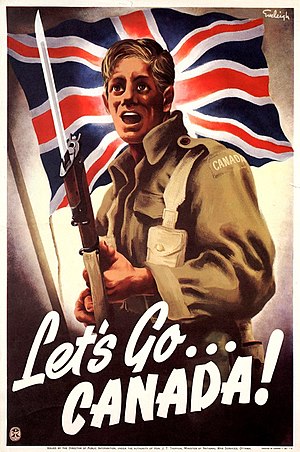Looking at the these Posters, one wonders what is behind the smiles when Americans meet Japanese in the course of business or as next door neighbors in the States. Relations have been good since the re-construction of Japan after the War....
................................................................................

................................................................................

US Army poster prepares the public for the invasion of Japan after ending war on Germany and Italy.
Let's Go Canada! by Henri Eveleigh.
Date 1939–1945

Leaflet dropped on Hiroshima before the atomic bomb, showing the names of 12 Japanese cities targeted for destruction by firebombing. Hiroshima was not listed. The other side contained text saying "we cannot promise that only these cities will be among those attacked ..."
Caption from CIA article: Front side of OWI notice #2106, dubbed the “LeMay bombing leaflet,” which was delivered to Hiroshima, Nagasaki, and 33 other Japanese cities on 1 August 1945. The Japanese text on the reverse side of the leaflet carried the following warning: “Read this carefully as it may save your life or the life of a relative or friend. In the next few days, some or all of the cities named on the reverse side will be destroyed by American bombs. These cities contain military installations and workshops or factories which produce military goods. We are determined to destroy all of the tools of the military clique which they are using to prolong this useless war. But, unfortunately, bombs have no eyes. So, in accordance with America's humanitarian policies, the American Air Force, which does not wish to injure innocent people, now gives you warning to evacuate the cities named and save your lives. America is not fighting the Japanese people but is fighting the military clique which has enslaved the Japanese people. The peace which America will bring will free the people from the oppression of the military clique and mean the emergence of a new and better Japan. You can restore peace by demanding new and good leaders who will end the war. We cannot promise that only these cities will be among those attacked but some or all of them will be, so heed this warning and evacuate these cities immediately.” (See Richard S. R. Hubert, “The OWI Saipan Operation,” Official Report to US Information Service, Washington, DC 1946.)"
Licensing:
[edit]
- Source: Josette Williams, "The Information War in the Pacific, 1945", 'CIA Studies in IntelligenceVol. 46, No. 3 (2002), online at
90,000–166,000 killed in Hiroshima[1]
60,000–80,000 killed in Nagasaki[1]
Total: 150,000–246,000+ killed
| A Japanese report on the bombing characterized Nagasaki as "like a graveyard with not a tombstone standing" |
On 12 August the Emperor Hirohito informed the imperial family of his decision to surrender.
Hirohito recorded on 14 August his capitulation announcement which was broadcast to the Japanese nation the next day despite a short rebellion by militarists opposed to the surrender.
In his declaration, Hirohito referred to the atomic bombings:
Moreover, the enemy now possesses a new and terrible weapon with the power to destroy many innocent lives and do incalculable damage. Should we continue to fight, not only would it result in an ultimate collapse and obliteration of the Japanese nation, but also it would lead to the total extinction of human civilization. Such being the case, how are We to save the millions of Our subjects, or to atone Ourselves before the hallowed spirits of Our Imperial Ancestors? This is the reason why We have ordered the acceptance of the provisions of the Joint Declaration of the Powers.
In his "Rescript to the soldiers and sailors" delivered on 17 August, he stressed the impact of the Soviet invasion and his decision to surrender, omitting any mention of the bombs.
During the year after the bombing, approximately 40,000 U.S. troops occupied Hiroshima while Nagasaki was occupied by 27,000 troops.




No comments:
Post a Comment